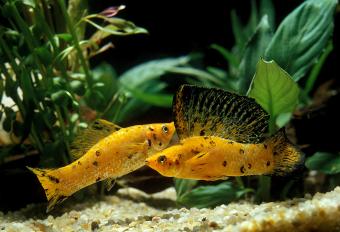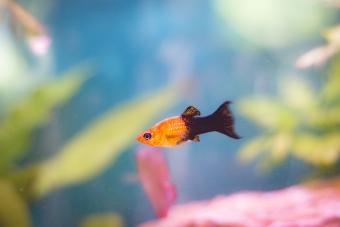
Whether you want to breed goldfish yourself or you're just curious about how it all works, learning how goldfish reproduce can be entertaining as well as enlightening. Goldish are egg layers rather than livebearers, so winding up with a successful hatch is more of a challenge than watching guppies give birth over and over again.
Telling Male Goldfish From Females
The differences between male and female goldfish are very subtle, and you usually can't spot them until the fish are mature.
- Males tend to have tiny tubercles around their heads, gills, and front of their pectoral fins that become more pronounced when they are in breeding condition. Their vents are also slightly caved in.
- Females tend to be a plumper overall with rounded bellies. Their vents also protrude slightly, especially when they are full of eggs.
Ideal Tank Set Up
A single pair of goldfish should be set up in a minimum 30-gallon aquarium with a filtration system. You'll need a second aquarium of the same size to move the adult pair into after spawning is completed; otherwise, they will likely eat their eggs.
Keep the bottom of the tank bare, but add a few real or artificial plants, or add a spawning mop instead. The eggs will stick to the plants or mop, which keeps them a little safer from the parents until you move them out of the spawning tank. Some eggs may also stick to the floor.
Simulating Seasonal Temperature Change
In the wild, goldfish begin spawning in the spring when the water begins warming up. To recreate this situation in your tank:
- Keep the temperature around 50°F.
- To encourage spawning, gradually raise the temperature two or three degrees each day until it reaches about 74°F.
If your goldfish are healthy and mature, ideally two to three years old, they will come into breeding condition and begin displaying spawning behavior.
How Do Goldfish Mate?
Spawning behavior isn't difficult to spot.
- The female will look plumper than ever because she is filled with eggs, and the male will begin chasing her relentlessly.
- As the male chases her, you'll see him press his head against her whenever he catches up with her. This is his way of trying to get her to release her eggs. Look closely at the female's vent. When she's ready to release eggs, you'll notice that her vent protrudes more than it normally does.
- When the female releases her eggs, the male releases his milt, and this fertilizes the eggs. The eggs will drop down in the tank and stick to any surface they touch, and this is where they will stay as they develop over the next several days.
Incubation and Hatching
Once the eggs are laid, it's time to transfer the pair to the extra tank. The difference between fertilized and unfertilized eggs is easy to spot. In a day or two, the fertilized eggs will look rather clear with a dark spot in the middle. The unfertilized eggs will turn dark and can be removed. Any fertile eggs should hatch after an incubation period of five to seven days.
How Many Babies Do Goldfish Have?
A female can lay up to 10,000 eggs but this doesn't mean you should expect to have that many babies when breeding. Only a small amount of these eggs will be viable as not all will be fertilized by the male. The parents will also attempt to eat the eggs so the sooner they're removed from the tank the better chance you have to increase the final number of fry that are hatched. Of the eggs that do hatch, do not be surprised if only about 30% of the fry live long enough to become adults. The fish are hatched in large numbers because a large portion of them are expected to die from disease due to their fragile state.
Feeding the New Fry
The newly hatched fry are extremely small and must be fed very nutritious, yet very small live food usually available at aquarium shops.
From birth to two weeks:
- Newly hatched brine shrimp
- Infusoria
As the fry grow, you can gradually begin to feed them larger foods like daphnia, microworms, and powdered spirulina. Eventually, they will be large enough to eat premium goldfish flakes and pellets.
The Goldfish Reproduction Cycle Continues
With the proper care and feeding, the fry will reach full maturity around one year of age in most cases. Once they come into breeding condition, they will be ready to begin the process of reproducing for themselves.







